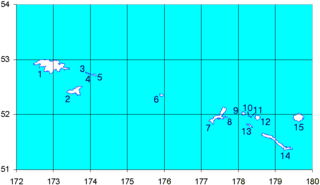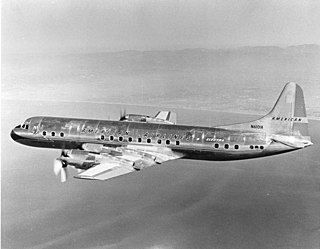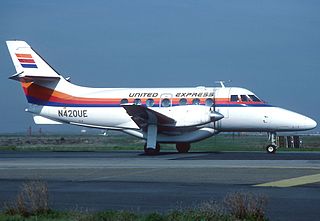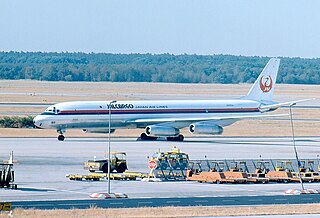
Reeve Aleutian Airways was an airline headquartered in Anchorage, Alaska, United States. It ceased operations on December 5, 2000. Reeve Aleutian was named, possibly as a pun on the word revolution, by combining founder Robert C. Reeve's surname and the Aleutian Islands, its primary destination.

Shemya or Simiya is a small island in the Semichi Islands group of the Near Islands chain in the Aleutian Islands archipelago southwest of Alaska, at 52°43′27″N174°07′08″E. It has a land area of 5.903 sq mi (15.29 km2), and is about 1,200 miles (1,900 km) southwest of Anchorage, Alaska. It is 2.73 miles (4.39 km) wide and 4.32 miles (6.95 km) long.

Eareckson Air Station, formerly Shemya Air Force Base, is a United States Air Force military airport located on the island of Shemya, in the Alaskan Aleutian Islands.

American Airlines Flight 320 was a scheduled flight between Chicago Midway Airport and New York City's LaGuardia Airport. On February 3, 1959, the Lockheed L-188 Electra performing the flight crashed into the East River during its descent and approach to LaGuardia Airport, killing 65 of the 73 people on board. Weather conditions in the area were poor, and the aircraft descended through dense clouds and fog. As it approached the runway, it flew lower than the intended path and crashed into the icy river 4,900 feet (1,500 m) short of the runway. American Airlines had been flying the newly-developed Lockheed Electra in commercial service for only about two weeks before the crash, and the accident was the first involving the aircraft type.

Sosoliso Airlines Flight 1145(SO1145/OSL1145) was a scheduled Nigerian domestic passenger flight from Nigeria's capital of Abuja (ABV) to Port Harcourt (PHC). At about 14:08 local time on 10 December 2005, Flight 1145 from Abuja crash-landed at Port Harcourt International Airport. The aircraft, a McDonnell Douglas DC-9-32 with 110 people on board, slammed into the ground and burst into flames. Immediately after the crash, seven survivors were recovered and taken to hospitals, but only two people survived.

American Airlines Flight 383 was a nonstop flight from New York City to Cincinnati on November 8, 1965. The aircraft was a Boeing 727, with 57 passengers, and 5 crew on board. The aircraft crashed on final approach to the Cincinnati/Northern Kentucky International Airport located in Hebron, Kentucky, United States. Only three passengers and one flight attendant survived the accident.

Northern Air Cargo, LLC (NAC) is an American cargo airline based in Anchorage, Alaska, United States. NAC operates a small fleet of Boeing 737-300, Boeing 737-400 and Boeing 737-800 freighter aircraft within the state of Alaska as well as widebody Boeing 767-300 freighter services throughout the Caribbean and South America. Other services include aircraft maintenance services through its subsidiary, Northern Air Maintenance Services, on demand charters and consolidation of cargo. With a main base at the Ted Stevens Anchorage International Airport, NAC also operates out of a hub at Miami International Airport. NAC is a division of Saltchuk which is the corporate parent of a number of transportation and distribution companies including Aloha Air Cargo, a cargo airline based in Hawaii.

Alaska Airlines Flight 1866 was a regularly scheduled passenger flight operated by Alaska Airlines from Anchorage, Alaska, to Seattle, Washington, with several intermediate stops in southeast Alaska. The aircraft was a Boeing 727-100 with U.S. registry N2969G manufactured in 1966. On September 4, 1971, the aircraft operating the flight crashed into a mountain in Haines Borough, about 18 miles west of Juneau, Alaska, while on approach for landing. All 111 people aboard were killed. The subsequent investigation found that erroneous navigation readouts led the crew to descend prematurely. No definitive cause for the misleading data was found. It was the first fatal jet aircraft crash involving Alaska Airlines, and remained the deadliest single-aircraft accident in United States history until June 24, 1975, when Eastern Air Lines Flight 66 crashed. It is still, however, the worst air disaster in Alaska state history.

American Airlines Flight 910, a four-engine Douglas DC-6 propliner, collided in mid-air with a single engine Temco Swift on final approach to Dallas Love Field on June 28, 1952, over Dallas, Texas. The DC-6 was carrying 55 passengers and 5 crew members from San Francisco, California. The DC-6 landed with no injuries to any of its 60 occupants, while both occupants of the two-person Swift died when their aircraft impacted the ground.

United Express Flight 2415 was a regularly scheduled flight in the northwest United States from Seattle to Pasco, Washington, operated using a BAe Jetstream 31. Late on Tuesday, December 26, 1989, Flight 2415 crashed while attempting to land at Pasco's Tri-Cities Airport, killing both pilots and all four passengers aboard.

Delta Air Lines Flight 723 was a flight operated by a McDonnell Douglas DC-9 twin-engine jetliner, operating as a scheduled domestic passenger flight from Burlington, Vermont, to Logan International Airport in Boston, Massachusetts, with an intermediate stop in Manchester, New Hampshire. On July 31, 1973, at 11:08 a.m., while on an instrument landing system (ILS) instrument approach into Logan in low clouds and fog, the aircraft descended below the glidepath, struck a seawall, and crashed. All 89 of the occupants aboard were killed, including an initial survivor who died more than 4 months after the crash.

Alaska Central Express Flight 51 was an Alaska Central Express flight from Anchorage to King Salmon and Dillingham, Alaska. On 8 March 2013, the Beechcraft 1900C-1 serving the flight crashed into a mountain on approach to Dillingham Airport, killing both crew members on board.

Japan Air Lines Cargo Flight 1045 was a charter flight on January 13, 1977, from Grant County, Washington, to Tokyo, Japan, with a stopover in Anchorage, Alaska. The flight crashed during the initial climb shortly after takeoff from Anchorage, in part because the captain, Hugh L. Marsh, was intoxicated as shown by a blood alcohol level of 0.29; the co-pilot and the other crew were not impaired. All of those on board, including three flight crew members, were killed in the crash.

Air Transport International Flight 805 was a regularly scheduled domestic cargo flight from Seattle to Toledo operated by Burlington Air Express. On February 15, 1992, the Douglas DC-8 operating the flight crashed during a second go-around attempt at Toledo Express Airport, killing all four people on board. The National Transportation Safety Board (NTSB) determined that the accident was caused by pilot error due to the aircraft's control not being maintained.

On 23 December 1983, Korean Air Lines Flight 084 (KAL084), a McDonnell Douglas DC-10-30CF performing a cargo flight, collided during its takeoff roll with SouthCentral Air Flight 59 (SCA59), a Piper PA-31-350, on runway 06L/24R at Anchorage International Airport, as a result of the KAL084 flight crew becoming disoriented while taxiing in dense fog and attempting to take off on the wrong runway. Both aircraft were destroyed, but no fatalities resulted.

Capitol International Airways Flight C2C3/26 was a chartered McDonnell Douglas DC-8 Military Airlift Command (MAC) contract flight operated by Capitol Air from McChord Field in Tacoma to Cam Ranh Bay in Southern Vietnam via stopovers at Anchorage and at Yokota Air Base in Japan. The aircraft crashed after a botched take-off attempt from Runway 06R at Ted Stevens Anchorage International Airport on November 27, 1970. Of the 229 people aboard the jet, 47 perished due to the post-crash fire with 49 people injured.

Japan Air Lines Cargo Flight 46E was a scheduled cargo flight on 31 March 1993, operated by Evergreen International Airlines, on behalf of Japan Air Lines, from Anchorage International Airport, in Anchorage, Alaska, to O'Hare International Airport, in Chicago. After departure, while climbing through 2,000 feet, the pylon for engine two detached, causing the whole engine to fall off the wing. The pilots managed to land the 747 back at Anchorage without further incident.

The crash of Alaska Airlines Flight 60 was an accident involving a Boeing 727-81 of the American airline Alaska Airlines at Ketchikan International Airport in Ketchikan, Alaska, United States, on April 5, 1976, resulting in the death of a passenger with 32 serious and 17 minor injured survivors among the initial 50 passengers and crew on board.

Northwest Orient Airlines Flight 324 was a military charter flight from Haneda Airport to McChord Air Force Base. On the morning of January 19, 1952, the flight crashed into Hecate Strait in British Columbia, Canada, while making an emergency landing at Sandspit Airport. All three crew members and 33 of the 40 passengers were killed, making the flight the third-deadliest aviation accident in Canada at the time.



















